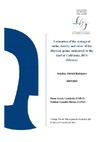Please use this identifier to cite or link to this item:
https://accedacris.ulpgc.es/jspui/handle/10553/74441
| Title: | Estimation of the ecological niche, density and cover of the Muricea genus (octocoral) in the Gulf of California, BCS (Mexico) | Authors: | Aldrich Rodríguez, Ariadna | Director: | García Castañeda, Omar González Dávila, Melchor |
UNESCO Clasification: | 251001 Oceanografía biológica | Keywords: | Gulf of California (Mexico) Octocorals |
Issue Date: | 2020 | Abstract: | The Gulf of California (GC) is categorized into three regions (upper, central and lower) that differ in their physical, chemical, topographical and biological conditions, counting with different abundances of species. The Upper Gulf (UG) is characterized by having a greater variety of species and primary production, compared to the other two regions. The sea gorgonian Muricea genus shows a higher distribution in the UG and near the Great Islands (Tiburón and Angel de la Guarda), whereas its distribution decreases at lower latitudes (in the mouth of the gulf or lower gulf), and it is known that this high abundance in the northern zone is related with the polyp size and the amount of food. It is important to determine the main environmental variables that affect the distribution of a species for its conservation and management. Hence, the objective of this research was to determine the environmental factors that affect the distribution of Muricea genus in the GC, by indicating their presence-absence, abundance and cover. 155 reefs were surveyed using 30 x 1m visual transects parallel to the coast, during years 2009, 2010 and 2013. Reefs were classified in ten different regions of the GC, dividing into each region shallow and deep zones. Species Distribution Models (SDMs) were developed to be able to study thirteen species of octocorals, all within the Muricea genus. Generalized Linear Models were used to estimate the significant variables that explain the SDMs by STATISTICA software. The results showed that the main environmental variables that influence in presences or absences of each species were the current velocity and sea surface temperature. The main variables that control the abundance and cover were nutrients, mainly phosphates and silicates. The strong currents prevent fertilization and settlement of the larvae in a certain area. However, it is observed that a high temperature is not necessary for larval settlement, but is necessary for gametogenesis. On the other hand, to increase the abundance of organisms and the growth rate, they need the nutrients, mainly phosphates and silicates, that in the same time these two nutrients have the greatest effect on phytoplankton growth. Besides, nitrates are also important, but they further control the growth of macroalgae, which are spatially competing with octocorals. Also it is important to note that an excess of primary production can affect negatively in the ecology of corals. This study can be used in further research to predict and infer their range of distribution and to inform stakeholders for the conservation and management decisions on the possible response of Muricea species to environmental changes. | Department: | Departamento de Química | Faculty: | Facultad de Ciencias del Mar | Degree: | Grado en Ciencias del Mar | URI: | https://accedacris.ulpgc.es/handle/10553/74441 |
| Appears in Collections: | Trabajo final de grado Restringido ULPGC |
En el caso de que no encuentre el documento puede ser debido a que el centro o las/os autoras/es no autorizan su publicación. Si tiene verdadero interés en el contenido del mismo, puede dirigirse al director/a o directores/as del trabajo cuyos datos encontrará más arriba.
Show full item recordPage view(s)
123
checked on Aug 10, 2024
Download(s)
36
checked on Aug 10, 2024
Google ScholarTM
Check
Share
Export metadata
Items in accedaCRIS are protected by copyright, with all rights reserved, unless otherwise indicated.
